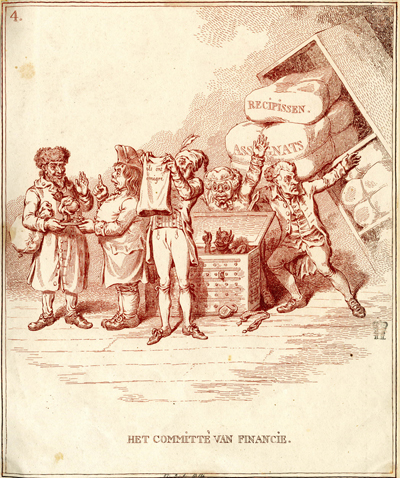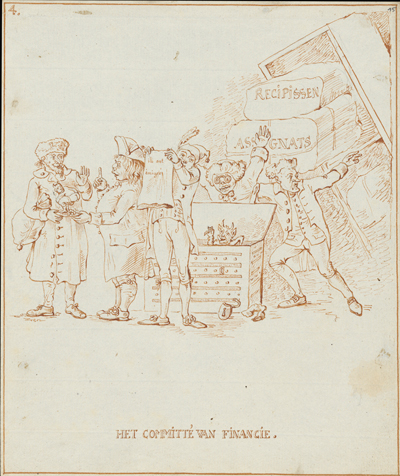Het Committé van Finance
This is the fourth plate of a twenty plate series, Hollandia Regenerata, etched by Gillray based on drawings by the Swiss soldier, painter, and caricaturist, David Hess. For more about David Hess, and the political and artistic context of the series satirizing the newly-created and French-supported Batavian Republic, see my Introduction.
The title can be translated as "The Committee of Finance."

Het
Committé van Finance
[1796?]
© Trustees of the British Museum
As with all the plates in the series, the corresponding page to the image contains one or more appropriately ironic Biblical quotations in Dutch and English and a satiric "Explanation" in French. In this case, the accompanying texts are more than usually necessary to understand the print.
The Biblical quotation is as follows:
Ecclesiasticus, Jesus Sirach, xl. 13. "The goods of the unjust shall be dried up like a river, and shall vanish with a noise, like a great thunder in rain."
Here is the French text of the "Explanation."
Helas! ou sont les tems heureux, ou nos coffres régorgeoient d'or ! mais, ils ont émigrés, les beaux ducats! ils ont passé chez nos frêres, les Français! dit le Secretaire, en sécouant tristement un sac vuide.
Cependant une nouvelle source d'oppûlance va s'ouvrir. Elle n'est pas trop pûre, puisqu'elle se trouve dans le derriere du petit automate qu'un membre du Committé vient d'achetér d'un honête Hebreux, qui assure que la figure, nourrie avec les larmes des partisans d'Orange, rendra tous les jours 50 ducats par selles régulieres. Que n'essaiye-t-on dans un cas desesperé? Ça vaudra toujours mieux que le tas d'assignats, qui se grossit comme une lavange. Déja elle ménace ruine-se détache-tombe-gare, messieurs! le choc pourrait vous écraser.
And here is my free English translation.
Alas! Where are the happy times when our coffers were stuffed with gold? But they have gone away, those beautiful ducats. They have gone to our brothers, the French, says the Secretary, sadly shaking an empty sack. However, a new source of wealth will open. It is not too clean, since it comes from the rear of a small automaton which a member of the Committee just bought from an honest Jew, who assures us that the figure, nourished with the tears of Orangist partisans, will produce 30 ducats a day in regular stools. What won't one try in a desperate situation? It will always be better than the heap of assignats which grows ever bigger like a tidal wave. It already threatens ruin. If it falls from its station, gentlemen, the shock could crush us.
When the French issued their famous "Decree for Proclaiming the Liberty and Sovereignty of all Peoples" in December of 1792, the downtrodden of nations who suffered under autocratic rule were understandably attracted by rhetoric that promised "the suppression of . . . established authorities and of the existing taxes, the abolition of the tithes, of feudalism, of seignioral rights, both feudal and censuel, . . . of real and personal servitude, of the privileges of hunting and fishing, of the nobility, and generally of all privileges." They didn't often notice that, even in that proclamation (article 10), there were bills to be paid by the "liberated" country to their French "liberators."
There shall be made a list of the expenses which the French Republic shall have incurred for the common defence and of the sums which it may have received, and the French nation shall make arrangements with the government which shall have been established for that which may be due; and in case the common interest should require that the troops of the Republic remain beyond that time upon the foreign territory, it shall take suitable measures to provide for their subsistence.
According to one estimate,"the French 'liberators' started with exacting a war indemnity of 100 million guilders (equal to one-third of the estimated Dutch national income at the time."
In Plate 4, then, Hess portrays at least one result of this desperate situation. The Secretary of the Batavian Finance Committe stands before an unlocked and empty coffer ("dried up like a river," as the passage from Ecclesiasticus puts it). That coffer used to be flowing with gold ducats, but now contains nothing but a grinning devil. The Secretary holds up an equally empty money bag upon which is inscribed the whereabouts of the missing ducats—"ils ont emigré (they have emigrated) to France. An empty purse lies at his feet.
Meanwhile two other members of the Committee are in danger of being crushed by the mounting bales of worthless paper currency (Recipissen and Assignats) that they have been forced by their French masters to accept in place of gold. According to Joost Rosendaal whose "Nawoord" to the 2007 facsimile edition of Hollandia Regenerata is essential reading for anyone interested in the series, the two figures may represent the Haarlem textile manufacturer Koenraad Hovens and the Amsterdam banker Nicolaas van Staphorst. From January to August 1795, both Hovens and Staphorst were members of the Provisional Representatives of the People of Holland. Staphorst was on both the Finance and the Foreign Affairs Committees.
In the face of increasing taxation, and a devalued currency, the anti-semitic Hess shows the last member of the finance committee in talks with the sterotypical bearded Jewish money lender in a crude scheme to produce hard currency. The image may refer to some desperate, alternative financial vehicle apart from recipissen and assignats to manage Holland's debts, but if so, I haven't found it.

Het
Committé van Finance
[1796?]
© Zentralbibliothek Zürich
As in most of the plates of Hollandia Regenerata, Gillray follows the Hess's drawing very closely. The disposition of the figures and the details and meaning of the print all derive from Hess, but Gillray has sharpened every line and with a wonderful use of shading given a depth and solidity to the ground and the figures that is missing in the original Hess drawing. The vest and legs of the man on the far right, for instance have more weight and definition in Gillray's etching. The textures of the coat, hat, and beard of the Jewish man have been much better realized. And the feet and stance of several of the figures have been subtly adjusted to make them seem less flat and awkward.
Sources and Reading
- Commentary from the British Museum on Het Committé van Finance.
- "Batavian Republic," Wikipedia
- "David Hess (painter)," Wikipedia
- "David Hess," SIKART Dictionary
- David Hess, Hollandia Regenerata (1797), Nawoord by Joost Rosendahl, Uitgeverij Vantilt, 2007
- "Decree for Proclaiming the Liberty and Sovereignty of all Peoples. December 15, 1792,"
- ",Koenraad Hovens" Wikipedia
- "Nicolaas van Staphorst," Wikipedia
- "Assignat," Wikipedia
- "Financial history of the Dutch Republic," Wikipedia
Comments & Corrections
NOTE: Comments and/or corrections are always appreciated. To make that easier, I have included a form below that you can use. I promise never to share any of the info provided without your express permission.